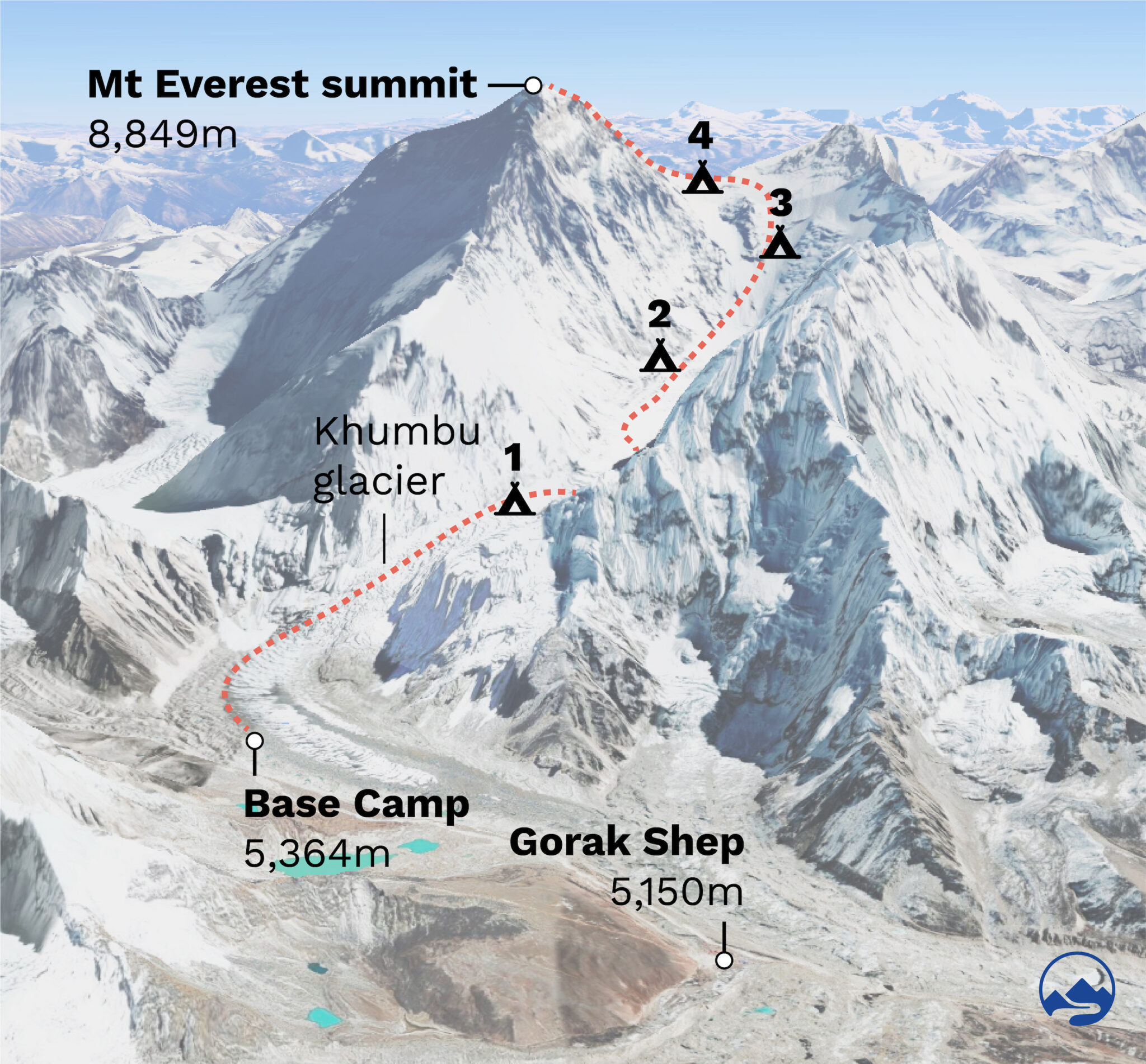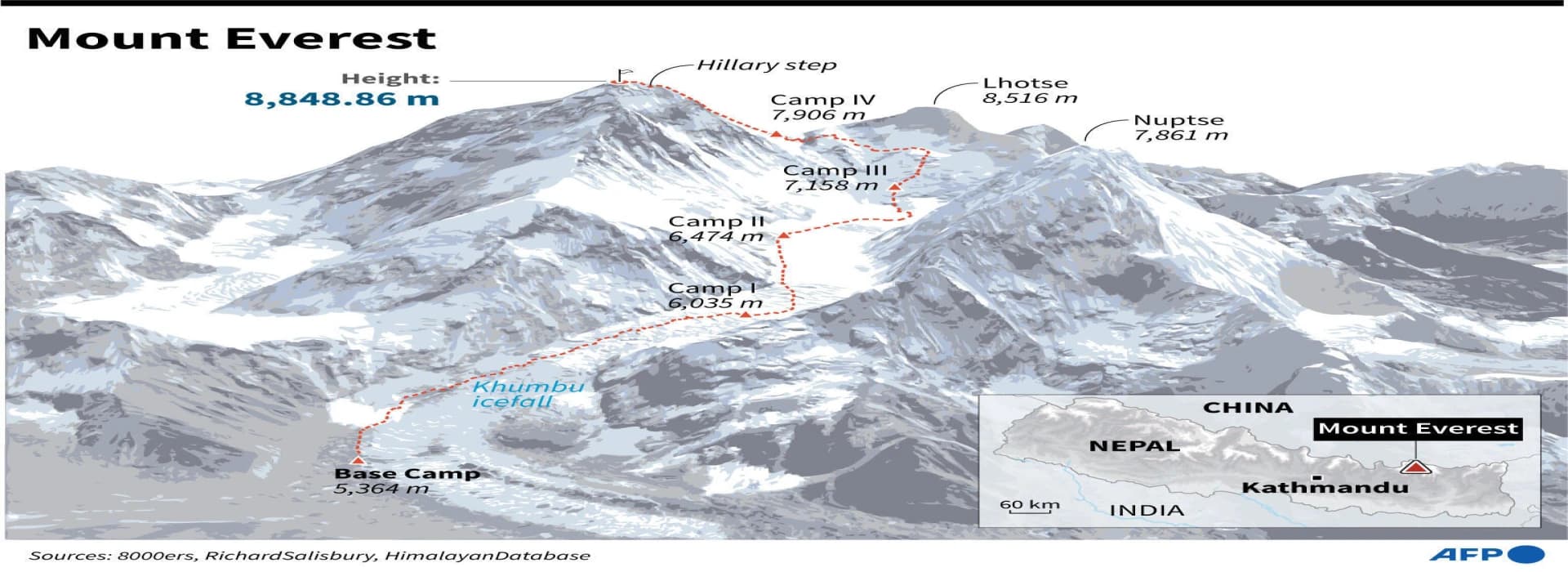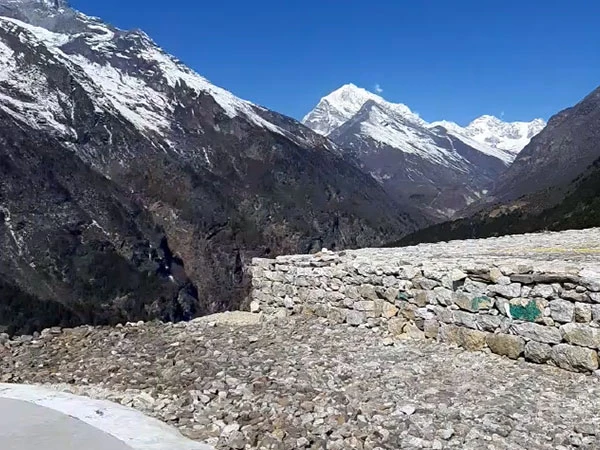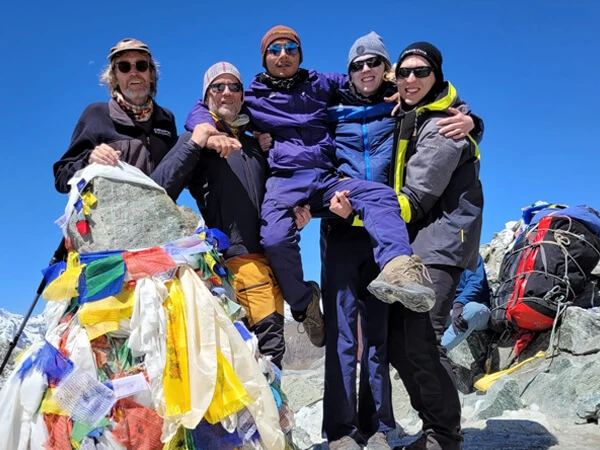At an altitude of 5,364 meters (17,599 feet), Everest Base Camp is more than just a location; it is an icon of trekking and high-altitude trekking. For many people, Everest Base Camp is the pinnacle of their trekking life. Atrek to EBC is NOT only about the destination, it is about the journey, pushing boundaries of your perceived limits, the magnificence of the Himalayas within astonishing experiences of challenge.
At an altitude greater than 5,000 meters, you will be in a truly unique place with thin air and spectacular views. Even the vegetation can indicate elevation, as the snow and wind-blasted high-altitude alpine plants decorate the bare ground, a reminder that you have had the guts to be there.
This majestic elevation comes with a heavy price; your ascent negatively impacts your physical condition, but at the same time, creates a spiritual elevation in yourself, permitting you to flourish, contemplate, and evolve like never before.
Climbing to over 5,000 meters takes you into a rarefied world where the air is thinner and the views are grander. Here, even the vegetation changes, with alpine flora dotting the rugged landscape, reminding you that you’ve entered a domain few dare to explore. This elevation is not just physically demanding—it’s spiritually elevating, offering unparalleled opportunities for self-reflection and growth.
Everest Base Camp is high-altitude and has great appeal. People arrive from all areas of the world to take part in the trek that so many mountaineers/climbers have completed, and brag that they made it to Everest Base Camp.
With a little planning, some acclimatization, and some actual training and conditioning, this is a trek that almost anyone with the desire and ability to prepare can do.
If trekking is not for you and you want to see the heights of Everest Base Camp, take a helicopter tour that will fly you to Kala Patthar at 5545 m. (18,192 ft.) Regardless of how you arrive, you will have a height you can brag about - a triumph over will, body, and the excitement of discovery.
Everest Base Camp Altitude in Feet Profile - 2026
In 2026, Everest Base Camp (EBC) is still at 5,364 metres (17,598 feet) and has seen no official indication of changing elevation from recent prior years.
The actual elevation of Everest Base Camp (EBC) is well known and acclaimed internationally as a point of reference and for planning and navigation for trekkers, who will also enjoy the sensations of being in the most impressive Himalayas. Still, atop the world more than 5.3 kilometers above sea level, the Everest base camp (EBC) is surrounded by the most illustrious peaks, including Mount Everest, the tallest mountain in the world.
At this point, a trekker needs to know the altitude profile of the Everest Base Camp trekking route. In particular, there will be significant climbs and descents for the trekker, but they will climb and descend at the appropriate time for their best opportunities to acclimatize. The risks of altitude sickness can be mitigated by creating gradual ascensions up below Altitude sickness elevations, whilst having a couple of planned rest days at those planned elevations. Therefore, challenges will be easier to overcome and even more fun to do and less risky to enter.
The outlined schedule for the upcoming 2026 trip to Everest Base Camp has been proposed in terms of elevation, as this will be a low elevation at Lukla (about 9,383 feet) to a higher elevation throughNamche Bazaar, Tengboche, Dingboche, and Lobuche to Base Camp. The itinerary contains no less than two rest days, and when there are no rest days, the shorter hiking days paired with longer hiking days will also add elevation and provide the body an opportunity to acclimatize to lower air pressures and reduce the likelihood of high-altitude sickness.
Everest Base Camp Trek Altitude Breakdown Day By Day
| Day | Route | Start Elevetaion | Max Elevation | End elevation | Elevation Gain / Loss |
| 1 | Arrival in Kathmandu | 1,400 m / 4,593 ft | 1,400 m / 4,593 ft | 1,400 m / 4,593 ft | None |
| 2 | Fly Kathmandu to Lukla → Trek to Phakding | 1,400 m / 4,593 ft | 2,860 m / 9,383 ft | 2,660 m / 8,727 ft | +1,460m gain / -200m loss |
| 3 | Phakding → Namche Bazaar | 2,660 m / 8,727 ft | 3,440 m / 11,286 ft |
3,440 m / 11,286 ft |
+780m gain |
| 4 | Acclimatization Day (Hike to Everest View Hotel) | 3,440 m / 11,286 ft | 3,880 m / 12,730 ft | 3,440 m / 11,286 ft | +440m gain / -440m loss |
| 5 | Namche Bazaar → Tengboche | 3,440 m / 11,286 ft | 3,880 m / 12,730 ft | 3,880 m / 12,730 ft | +440m gain |
| 6 | Tengboche → Dingboche | 3,880 m / 12,730 ft | 4,320 m / 14,173 ft | 4,320 m / 14,173 ft | +440m gain |
| 7 | Acclimatization Day (Hike to Nangkartshang Peak) | 4,320 m / 14,173 ft | 5,083 m / 16,677 ft | 4,320 m / 14,173 ft | +763m gain / -763m loss |
| 8 | Dingboche → Lobuche | 4,320 m / 14,173 ft | 4,970 m / 16,302 ft | 4,970 m / 16,302 ft | +650m gain |
| 9 | Lobuche → Gorak Shep → Everest Base Camp → Gorak Shep | 4,970 m / 16,302 ft | 5,364 m / 17,598 ft | 5,180 m / 16,995 ft | +394m gain / -184m loss |
| 10 | Gorak Shep → Kala Patthar → Pheriche | 5,180 m / 16,995 ft | 5,644 m / 18,520 ft | 4,250 m / 13,944 ft | +464m gain / -1,394m loss |
| 11 | Pheriche → Namche Bazaar | 4,250 m / 13,944 ft | 3,440 m / 11,286 ft | 3,440 m / 11,286 ft | -810m loss |
| 12 | Namche Bazaar → Lukla | 3,440 m / 11,286 ft | 2,860 m / 9,383 ft | 2,860 m / 9,383 ft | -590m loss |
| 13 | Fly Lukla to Kathmandu | 2,860 m / 9,383 ft | 2,860 m / 9,383 ft | 1,400 m / 4,593 ft | -1,450m loss |
| 14 | Final Departure from Kathmandu | 1,400 m / 4,593 ft | 1,400 m / 4,593 ft | 1,400 m / 4,593 ft | 1,400 m / 4,593 ft |
How Low is Everest Base Camp Trek Altitude Compared to Mount Everest?
| Location | Altitude (Meters) | Altitude (Feet) |
| Mount Everest Summit | 8,848.86 | 29,031.7 |
| South Everest Base Camp | 5,364 | 17,598 |
| North Everest Base Camp | 5,150 | 16,900 |
| Difference (South EBC to Summit) | 3,484.86 | 11,433.7 |
| Difference (North EBC to Summit) | 3,3698.86 | 12,131.7 |
The Everest Base Camp (EBC), located in Nepal at an altitude of 5,364 meters (17,598 feet), and the peak of Mount Everest, is at an altitude of 8,848.86 meters (29,031.7 feet). The EBC’s altitude is 3,484.86 meters (11,433 feet) lower than Mount Everest.
For clarity, the trek to Everest Base Camp is a high-altitude trek for a number of trekkers. To summit Everest, you need mountaineering skills and have acclimatized to very high altitudes. The Base Camp is the starting point for climbers, and at an altitude where it is possible to be at risk of altitude sickness.
The elevation gain shows the scale of difficulty in getting to the summit from the base camp. While the trek to base camp can be tough, it can be accomplished by many. The ascent to the summit of Everest requires climbers to enter the "Death Zone" above 8,000 meters of elevation, where oxygen is dangerously low.
Base camp is high, but it represents only 60% of the total elevation of Mount Everest, which shows the massive vertical challenge climbers face after base camp.
Elevation of Everest Base Camp on The Trekking Trail

South Everest Base Camp
When trekkers discuss Everest Base Camp (EBC), they are typically referring to the South Base Camp in Nepal, one of two base camps for Everest and located at an incredible 5,364m (17,598ft) high. This is the designated finishing point for the classic trek to Everest Base Camp in the Khumbu region, and the departing point for climbers desiring to summit.
Although this is much lower than the summit of Everest (8,848 meters/29,032 feet), the trek to EBC is exhilarating; trekking at high altitude is exciting, while the views of many high mountains, including Ama Dablam, Lhotse, and Everest, are stunning. The trek to the South Base Camp begins with a flight (or trek) to Lukla, and traverses many of the notable names you will pass, including:
The South Base Camp trek starts with a flight or trek to Lukla and passes through several famous places such as:
- Lukla (2,860 m / 9,383 ft)
- Phakding (2,610 m / 8,563 ft)
- Namche Bazaar (3,440 m / 11,286 ft)
- Tengboche (3,867 m / 12,687 ft)
- Dingboche (4,410 m / 14,469 ft)
- Lobuche (4,940 m / 16,207 ft)
- Gorak Shep (5,164 m / 16,942 ft)
- Everest Base Camp (5,364 m / 17,598 ft)
North Everest Base Camp
As an alternative, the North Everest Base Camp in Tibet reaches around 5,150 m (16,900 feet). Although it is ever so slightly lower than the South Base Camp, the North Base Camp gives you a different culture and landscape - you will have significantly less tourist traffic and a different approach to the mountain. The trek on the northern side takes you across the high Tibetan plateau and into the open, expansive valleys, bleeding into Buddhist monasteries.
Some of the notable places you will hit are:
- Tingri (4,350 m/14,270 ft)
- Shelkar (4,300 m/14,108 ft)
- Rongbuk Monastery (4,980 m/16,339 ft)
- Everest North Base Camp (5,150 m/16,900 ft)
Both routes get you very close to the world's highest mountain, but each route offers its charm. The South is much more well-known, with the Sherpa culture, mountain trekking communities, and vibrant trekking villages, whilst the North has much more of a remote, plateau feel to it. Regardless of which side you choose to trek, both routes will give you an unforgettable backcountry experience for any traveller visiting the Himalayas.
Which Is The Highest Elevation on The Everest Base Camp Trek?
On the Everest Base Camp (EBC) trek, the highest trekked point will be at Kala Patthar, a nearby viewpoint to Gorak Shep, apart from base camp itself. Kala Patthar is 5,545 m (18,192 ft) above sea level and is famous for giving trekkers accomplished, unobstructed views of Mount Everest's summit and all the other peaks around, and possibly the most photographed or celebrated viewpoint on the trek.
It is advisable to go at dawn as the view of Everest, Lhotse, Nuptse, and the other high peaks is stunning.
Although EBC is at 5,364 m (17,598 ft) above sea level, the climb to Kala Patthar with Everest in view will take you the additional height of 181 meters (594 ft) to attain the highest viewpoint on your trek.
The trek up to Kala Patthar is very strenuous and steep; however, there will be absolute satisfaction and fulfillment when you've made it, as there's no other close-up view of the tallest mountain in the world other than from Kala Patthar.
If you want the entire Everest experience, it is highly recommended you add Kala Patthar to your plans - it is yet one more exercise of physical endurance and stamina, plus an amazing view.
Experiencing Life at Everest Base Camp Altitude
Everest Base Camp (5364 meters above sea level) offers climbers a unique and determinable daily rhythm of acclimatization, preparation, and rest. Each day begins early with a hot breakfast, followed by some low-altitude activity to assist acclimatization. Several climbers also make short treks to altitude sites, then returning to Camp to sleep at altitude; all in the "climb high, sleep low" philosophy.
Accommodation and Facilities
At base camp, all climbers will spend their nights in expedition tents with communal kitchen arrangement. The nights at base camp drop in temperature rapidly, so having a decent sleeping bag and liner is important for comfort and generally recommended. Teahouses lower down the trek will also have twin rooms with basic bedding, shared bathrooms (often squat types), and communal dining, which will often be warmed by a wood or yak dung stove. One could also sometimes pay for the luxury of a hot shower, but at high altitude and freezing temperatures, it is possible to find that the water may freeze, so comfort could be compromised.
Food & Water supply
Food is very calorically dense and heavy on carbohydrates - think dal bhat, pasta, soups, energy bars & Base Camp focuses on calorie-to-protein commensurations to deal with the exertions of altitude. Drink at least 3-4 L of water per day alongside the broad spectrum of changes listed here to reduce the effects of dehydration on the body. Boiled water is the ultimate convenience, and many trekkers on Everest aspire to use purification tablets so they can trek free of litter and not contribute to the sources of water contamination.
Communications and connectivity
Connectivity has improved and will continue to improve with developments like the Everest Link, a solar ISP at Base Camp that offers Wi-Fi as a help via a prepaid card and has limited signal and mobile service along the entire trekking route. Ncell and Nepal Telecom SIMs occasionally have 3G, but it is usually weak and only in specific trekked locations like Gorak Shep and Namche. Wi-Fi practically on the mountain is slow and can disappear as quickly as it arrived, and Sat phones are the only option in emergencies.
What is the Actual Altitude of Everest Base Camps?
1. Everest Base Camp (EBC)
Altitude: 5,364 meters (17,598 feet)
Everest Base Camp, located at the Khumbu Glacier, is the main starting place for climbers to access the summit (the South side).
Climbers should begin to feel the effects of altitude at this stage of the expedition. Base Camp has roughly 50% of the oxygen found at sea level. Climbers will most commonly spend a few days at Base Camp to let the altitude (and the effects) settle down before continuing their walk.
2. Camp I
Altitude: 6,065 meters (19,900 feet)
Camp I is just above the Khumbu Icefall, and is technically the first high camp out of Base Camp on your departure. Again, the altitude is considerably higher, and oxygen depletion falls to approximately 47% of sea level. The terrain could be extreme cold and avalanche country, and it is a flat section, like Base Camp, in the Western Cwm.
3. Camp II
Elevation: 6,400m (21,000ft)
Camp II is found in the Western Cwm, which is the glacial valley below the Lhotse Face. Camp II is of significance for acclimatization and for the climbers to prepare for summoning the energy to climb higher. On this climb to Camp II, a climber will need to pay careful attention to their energy stores because they are only getting 43% oxygen biologically, and their body is trying to acclimatize to the environment. Climbers will spend a certain number of nights at Camp II before starting to climb higher.
4. Camp III
Elevation: 7,162m (23,500ft)
Camp III is found on the Lhotse Face mid-elevation as you climb the steep section. There are fixed lines on the way to the camp. The Oxygen is now down to approximately 38%. At this altitude, most climbers use supplemental Oxygen to aid with the lack of Oxygen. With the lack of Oxygen there will be a risk of altitude sickness at this altitude, which can also be miserable.
5. Camp IV (South Col)
Altitude: 7,950 meters (26,085 feet)
Camp IV is located on the South Col, the lowest point (saddle) between Everest and Lhotse. This is the last base camp before the last ascent, and is just below the Death Zone. This altitude is where things start to fall apart for the human body due to the lack of oxygen (there is roughly, 33% of the oxygen that there is at sea level). Climbers are going to spend the least amount of time here before their final push.
6. The Summit of Mount Everest
Altitude: 8,848.86 meters (29,031.7 feet)
The actual summit of Mount Everest is the highest point on Earth. At the summit of Mount Everest, oxygen is only one-third that at sea level, climbers must use supplemental oxygen at this altitude to survive against the extreme, relentless winds, temperatures that can reach -60, and other perils of this barren land. The summit is the ultimate goal for all those who attempt Everest, but it is also the most deadly part of the trip because of exhausting conditions, altitude sickness, and now a much higher chance of altitude-related problems.
Understanding the Risks of High Altitude at Everest Base Camp

The Everest Base Camp (EBC) journey brings thrill-seekers up to incredible heights of almost 5,364 meters (17,598 feet) above sea level. Although this trek gives you an incredible sight and opportunity to meet the Himalayan people, it also introduces serious risks due to high elevation, mostly those related to altitude sickness.
What is Altitude Sickness?
Altitude sickness or acute mountain sickness (AMS) is the result of the body's inability to cope with reduced oxygen levels at high altitudes. At Everest Base Camp's height, the atmospheric pressure is drastically decreased, which means that the oxygen supply for breathing is lower. This oxygen deficit stresses the body, which can result in different forms of altitude sickness.
Types of Altitude Sickness
- Acute Mountain Sickness (AMS):
- The most common form of altitude sickness among EBC trekkers is AMS. The typical symptoms are headache, nausea, dizziness, and tiredness. Usually, AMS is a symptom that the body is not comfortable with the altitude.
- High Altitude Pulmonary Edema (HAPE):
- HAPE can be considered a severe condition that can go on to be fatal if you haven't acted on it well, and it is a situation where there is a build-up of fluid in the lungs. Some of the symptoms are: breathlessness, cough that won't go away, chest tightness, and tiredness. Immediate medical help is necessary.
- High Altitude Cerebral Edema (HACE):
- While the condition is rare, it can still be very serious and happen when the brain fills with fluid due to the high altitude. It is very similar to HAPE as to symptoms in that it can cause confusion, loss of coordination, hallucinations, and maybe unconsciousness. Just like HAPE, urgent help is required.
Why Is Altitude Sickness a Concern at Everest Base Camp?
When the rise is too quick and Everest Base Camp is at a very high altitude, the risk of altitude sickness also goes up. Most trekkers typically begin to feel the symptoms when they ascend above 3,000 meters, and the symptoms can get worse if they do not adjust properly. The trek gets to the levels where there is scarcity of oxygen, hence even those who are physically fit are the ones who are most at risk.
It is very important to understand the different kinds of altitude sickness and its threats to be safe while you plan the trip to the Everest Base Camp. Taking into account the power of high altitude makes the experience on this legendary trip safer and pleasant.
Symptoms of Altitude Sickness:
Altitude sickness symptoms may be mild or serious and usually develop within a few hours to a day after going up to high elevations.
- Mild Symptoms: Headache, nausea, dizziness, tiredness, lack of appetite, and sleep troubles are mild symptoms. Such mild symptoms are often the first indication of acute mountain sickness (AMS) and should be carefully monitored.
- Moderate Symptoms: When symptoms get worse, people who go for a trek can have a headache that does not go away, vomiting, feeling very weak, and breathlessness even when at rest.
- Severe Symptoms: Symptoms and High Altitude Pulmonary Edema (HAPE) and High Altitude Cerebral Edema (HACE) are very dangerous diseases. The main signs and symptoms of HAPE standing out are extreme breathlessness, cough producing frothy sputum, and chest tightness. Also, amongst the HACE symptoms are confusion, loss of coordination, inability to walk straight, hallucinations, and unconsciousness.A quick descent to lower altitudes and medical treatment is important.
Prevention of Altitude Sickness
The most critical thing is to stop the illness from starting, and you can do this if you listen carefully to your body while on the walk.
- Gradual Ascent: One of the travel-safe methods to avoid illness is going up slowly, so the body can be comfortable with the changing air pressure. Avoid rapid gain at an altitude by planning some rest days during the trip.
- Hydration and Nutrition: Drink lots of water. That will keep you hydrated, and eating a healthy diet will give your energy levels a boost.
- Avoid Alcohol and Smoking: Do not smoke or drink alcohol. It will both make it difficult for the body to adjust, and it will increase the likelihood of getting sick from the altitude.
- Medications: It is reported that some of the trekkers use drugs like acetazolamide (Diamox) as a preventive measure. But, this can only be taken with the agreement of a health professional.
- Listen to Your Body: When altitude sickness signs appear, stop going up until they improve. If they get worse, going down straight away is the only solution.
How Difficult is the Everest Base Camp Trek in terms of altitude?
Everest Base Camp (EBC) Trek is ranked as moderately to highly difficult, mainly due to altitude. From the starting point at Lukla, we begin at about 2,800 meters (9,200 feet) and we walk straight up to base camp at 5,364 meters (17,598 feet). This is a vertical gain of 2,500 meters (8,200 feet) over 12-14 days, subjecting the trekker to stepwise loss of air density and hence oxygen, in turn making it considerably more difficult to breath and to sustain an effort level than at lower elevations.
The real challenge is the body's adaptation to altitude. The higher you go, the greater the risk of altitude sickness, especially above 3000 meters.
The actual trail will not require any technical skills, and climbing involves well-marked trails, moderate climbs, and descents. Nevertheless, the high altitude requires a degree of physical fitness and mental preparation.
Final Say About Everest Base Camp Altitude At 5,364m
Though the trek to Everest Base Camp is a challenging experience, it's no reason to stop you from trying to get yourself to Everest.
With good planning, training, and understanding of elevation acclimatization, you can do this famous trek in the Himalayas.
If that trek does not suit you, you can take a helicopter trip by air to Everest Base Camp at 5,545 meters (18,192 feet) to get great views and an amazing perspective of the area. To avoid confusion, altitude presents its own challenges, and that shouldn't be ignored.
Be fully prepared to make this a fun and safe trip. Ammonite Adventure is here to help you realize your dream of Everest by walking or flying.








